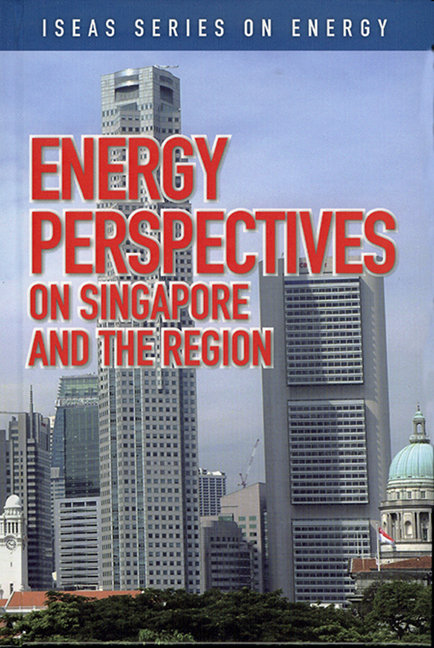Book contents
- Frontmatter
- Contents
- Foreword
- Preface
- The Contributors
- 1 Overview of Singapore's Energy Situation
- 2 Singapore's Changing Landscapes in Energy
- 3 Singapore's Role as a Key Oil Trading Centre in Asia
- 4 Large-Scale Solar PV Power Generation in Urban High-Rise Buildings in Singapore
- 5 The High-Carbon Story of Urban Development in Southeast Asia
- 6 Renewable Energy and the Environment: Technology and Economic Perspectives
- 7 Delivering Results in a Booming Rig Market
- 8 The Success Story of Rig Building in Singapore
- 9 The Singapore Oil Situation
- 10 Singapore Petroleum Company: Adding Value to the Singapore Oil Industry
- 11 Oil Storage: The Singapore Story
- REGIONAL and INTERNATIONAL
- 12 The Outlook for Energy: A View to 2030
- 13 India's Energy Situation: The Need to Secure Energy Resources in an Increasingly Competitive Environment
- 14 The Implications and Impacts of China's Oil Demand on the Asia Pacific
- 15 Energy Security Cooperation in Asia: An ASEAN-SCO Energy Partnership?
- 16 China's Energy Security: Geo-politics versus Interdependence
- 17 The Strategic Challenges for the United States and China in Global Energy Supply
- 18 China's Coal: Curse or Blessing
- 19 Japan's New Energy Strategy
- 20 Who Wins in the Asian Scramble for Oil?
- 21 New Horizons for Liquefied Natural Gas (LNG) East of Suez
- 22 Bio and Synthetic Fuels: An Alternative for Sustainable Mobility
- 23 Price Discovery for Middle East Refined Product Exports: A Natural Role for Dubai
- 24 The Outlook for Gas in Southeast Asia
- 25 Sakhalin-2 Project, a New Energy Source for the Asia Pacific: History in the Making
- Index
12 - The Outlook for Energy: A View to 2030
from REGIONAL and INTERNATIONAL
Published online by Cambridge University Press: 21 October 2015
- Frontmatter
- Contents
- Foreword
- Preface
- The Contributors
- 1 Overview of Singapore's Energy Situation
- 2 Singapore's Changing Landscapes in Energy
- 3 Singapore's Role as a Key Oil Trading Centre in Asia
- 4 Large-Scale Solar PV Power Generation in Urban High-Rise Buildings in Singapore
- 5 The High-Carbon Story of Urban Development in Southeast Asia
- 6 Renewable Energy and the Environment: Technology and Economic Perspectives
- 7 Delivering Results in a Booming Rig Market
- 8 The Success Story of Rig Building in Singapore
- 9 The Singapore Oil Situation
- 10 Singapore Petroleum Company: Adding Value to the Singapore Oil Industry
- 11 Oil Storage: The Singapore Story
- REGIONAL and INTERNATIONAL
- 12 The Outlook for Energy: A View to 2030
- 13 India's Energy Situation: The Need to Secure Energy Resources in an Increasingly Competitive Environment
- 14 The Implications and Impacts of China's Oil Demand on the Asia Pacific
- 15 Energy Security Cooperation in Asia: An ASEAN-SCO Energy Partnership?
- 16 China's Energy Security: Geo-politics versus Interdependence
- 17 The Strategic Challenges for the United States and China in Global Energy Supply
- 18 China's Coal: Curse or Blessing
- 19 Japan's New Energy Strategy
- 20 Who Wins in the Asian Scramble for Oil?
- 21 New Horizons for Liquefied Natural Gas (LNG) East of Suez
- 22 Bio and Synthetic Fuels: An Alternative for Sustainable Mobility
- 23 Price Discovery for Middle East Refined Product Exports: A Natural Role for Dubai
- 24 The Outlook for Gas in Southeast Asia
- 25 Sakhalin-2 Project, a New Energy Source for the Asia Pacific: History in the Making
- Index
Summary
INTRODUCTION
Energy is essential to our way of life, to economic progress, and to raising and maintaining living standards. The pursuit of economic growth and a better quality of life in developing countries is driving global energy demand. New supplies of reliable, affordable energy are needed. At the same time, concerns about future energy supply and climate change have heightened interest in energy supply options, energy prices and the effect of energy use on the environment. It is essential that industry plays an active role in the ongoing dialogue about the future of energy — one that is grounded in reality, focused on the long term and intent on finding viable solutions.
Each year, ExxonMobil prepares a detailed, long-term outlook of worldwide economic growth and energy demand. It uses this outlook to help plan its business. In order to develop the most comprehensive and accurate outlook, it incorporates the views of organizations such as the International Energy Agency and the U.S. Department of Energy — as well as those of other leading economic and energy experts — in its research.
ExxonMobil's outlook, presented in this chapter, extends to the year 2030.
ENERGY OUTLOOK BASIS
ExxonMobil assesses the energy demand outlook for nearly 100 countries, with the balance of the world covered in 15–20 country groups. To determine future demand for oil, gas, coal, electricity and more, it looks at economic drivers such as gross domestic product and population. Those factors are important because energy demand is closely linked to economic development. As societies develop, their energy needs expand as well.
To develop its final conclusions, ExxonMobil applies factors for efficiency improvement, and considers current trends and future expectations in consumption patterns, including issues such as competition between fuels and availability of supply. It also evaluates the supply outlook. Working closely with experts within ExxonMobil and with external data, it establishes resource estimates for both oil and gas and model production profiles for key countries.
- Type
- Chapter
- Information
- Energy Perspectives on Singapore and the Region , pp. 113 - 131Publisher: ISEAS–Yusof Ishak InstitutePrint publication year: 2007



